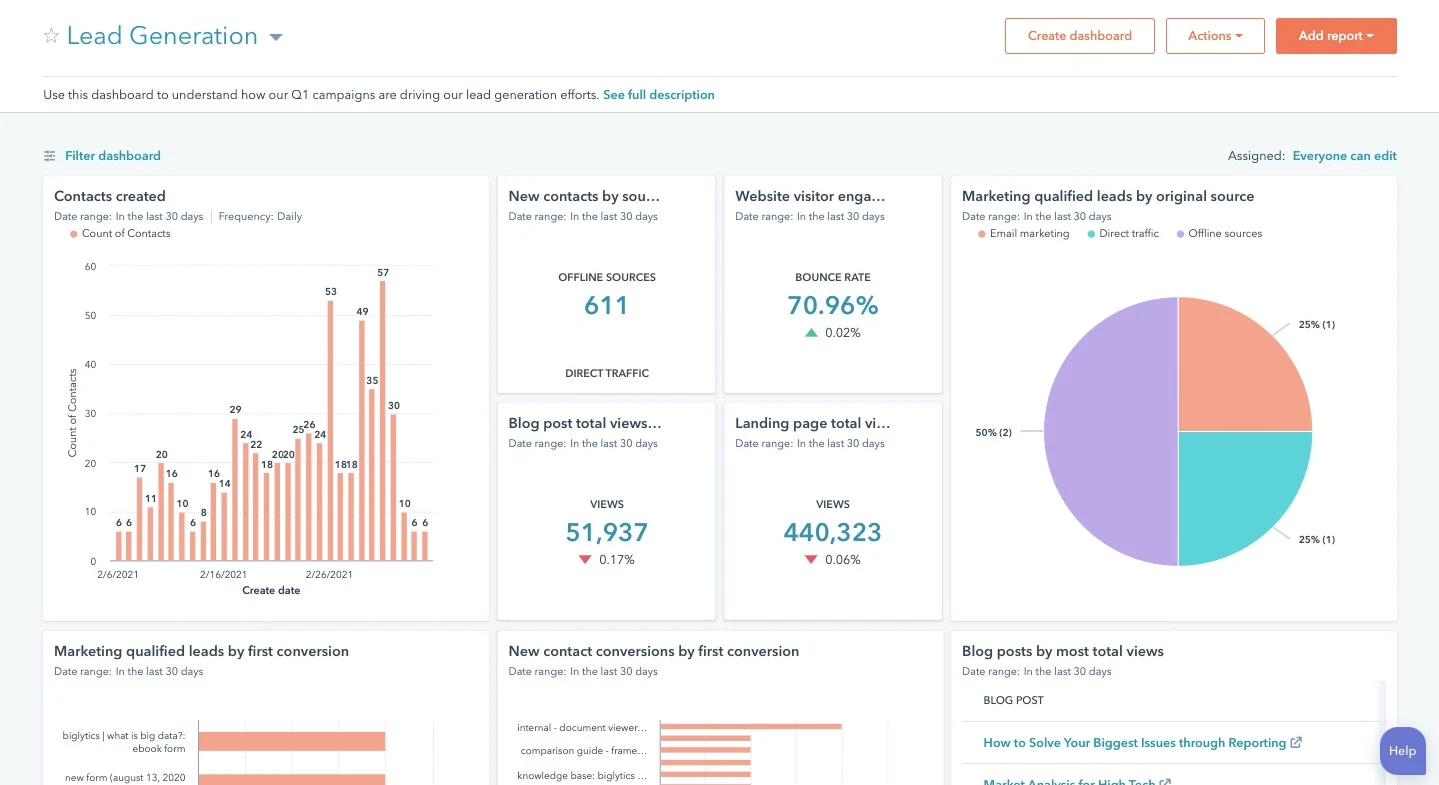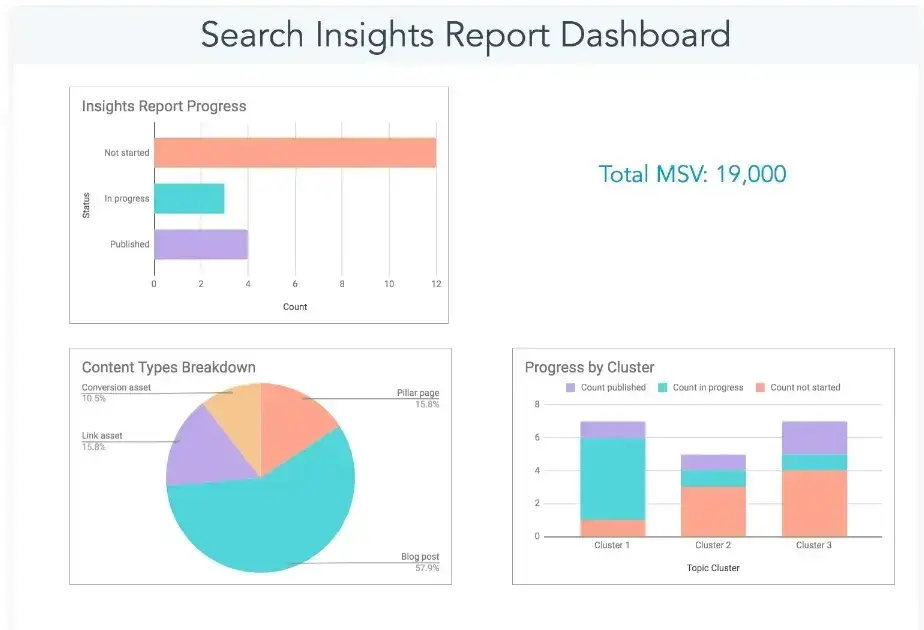The role of an SEO specialist today is to unite buyer problems with real solutions and use keyword data to drive business growth. And now we’re sitting on a trove of data about buyer behavior; what buyers’ search tells us about problems buyers are having, and how aware they are of the solution.
I’ve spent nearly a decade doing just that: helping SaaS, e-commerce, and service-based brands increase revenue from organic content, rank for high-converting keywords, and future-proof their content strategies across channels.
This guide breaks down the exact keyword research process I use with clients. I’ll show you how to find keywords that still get clicked, build out conversion-driven topic clusters, and map search intent to every stage of the buyer journey. These are the same methods that have helped my clients grow blog revenue by 254% YoY, earn top spots on Google, and even land citations in tools like ChatGPT.
Table of Contents
What is keyword research?
Keyword research is the process of finding and analyzing search terms (words and phrases) that people use to find information online, whether searching through traditional search engines such as Google, using conversational platforms and LLMs, or social media.
Previously, keyword research was synonymous only with Google, but search is far beyond this because search behavior has changed.
HubSpot’s research into the ways people search identified that:
- 31% use social media to search.
- 12% use AI chatbots to search.
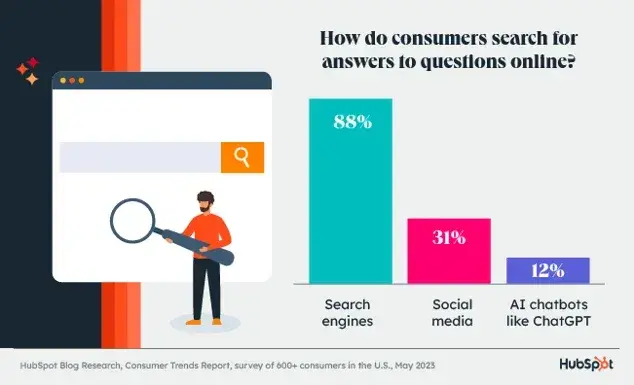
While these stats are incredibly important, I should add the caveat that HubSpot found that 88% of people are still using Google.
There’s no denying it: Right now, Google is still the platform with the largest share of search.
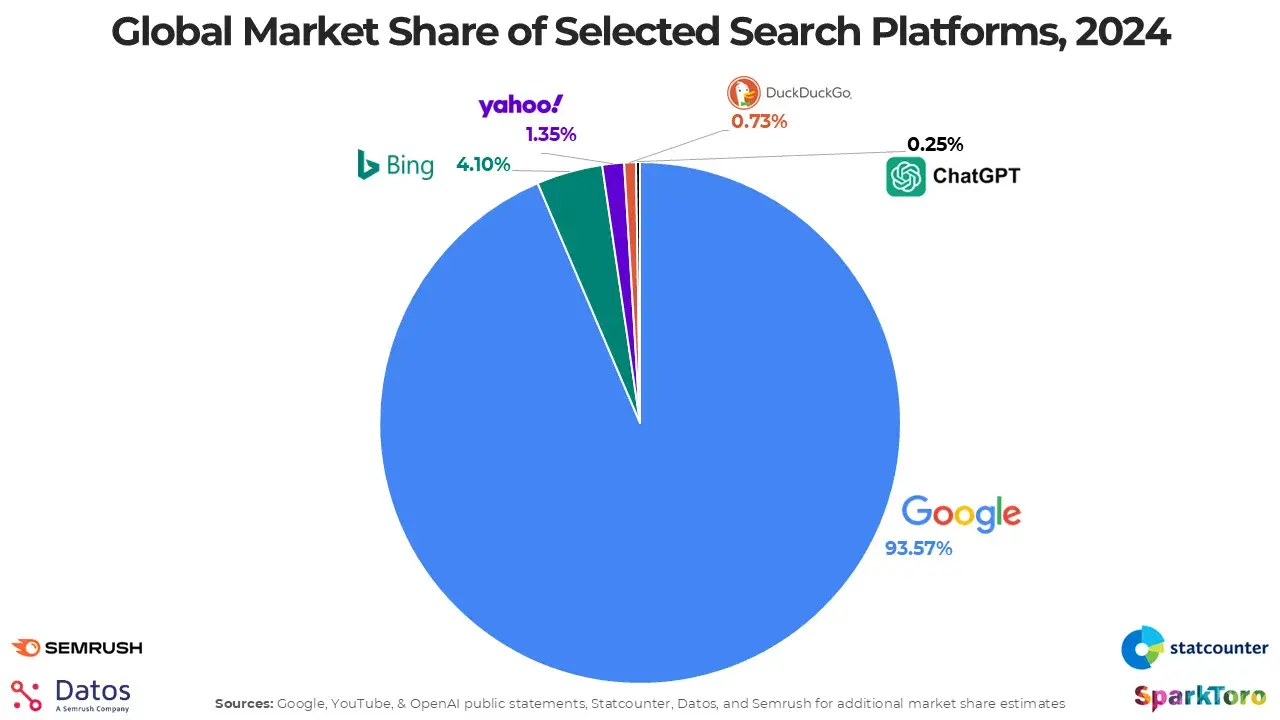
But this might change, and search evolution is one of the main reasons why conducting keyword research correctly (in pursuit of business growth) is so important.
Why is keyword research important?
Keyword research is important because it helps you find the overlap of keywords that:
- Aren’t too hard to rank for.
- You can confidently produce excellent content on.
- Have the right search intent to meet your business objectives (e.g., transactional keywords lead to sales).

Below, I elaborate on five key points that I think are exceptionally important for keyword research in modern-day SEO and achieving the three outcomes listed above.
1. Keyword research helps you understand your buyers.
Keyword research gives SEO specialists the tools to become the most informed marketers about buyers, their behaviour, problems, search habits, and receptiveness to solutions.
With this information, you bring considerable benefits to marketing in general.
When you know what your audience is searching for, you can create content that matches those terms.
Better, you can align marketing to create strategies across channels to target these keywords.
2. Keyword research unites strategies across channels.
Conversion from SEO relies on a searcher knowing what they need and being in a position to search for it. This mindset doesn’t happen overnight, and with holistic keyword strategies, it doesn’t need to.
While SEO waits for a searcher to become aware enough to search for something, social media can educate an audience until they’re ready to make their final search and are receptive to a new solution.
For example, if a business sells an ergonomic desk that reduces long-term posture-related issues, customers might finally convert on “ergonomic desk for home office.” But most people don’t know that they need such a desk. Instead, they search for things surrounding this, such as:
- Neck pain at work (20 searches per month).
- Best desks for home offices (110 searches per month).
- Improving posture at work (10 searches per month).
All searches can be identified using keyword research.
Once I’ve completed my keyword research, I’d create articles on topics that bring the right audience (people who need an ergonomic desk, whether they know it or not) to the website. I’d even create it if it were a search term that resulted in a zero-click search.
Why?
Because not all content has to be used for search engines.
When I’ve done my keyword research, I share it with other marketing teams. Assets, such as a blog, created for the keywords, can also be shared on social media and emails.
Important note: For this to work, you must have a content strategy that includes other marketing teams, and you must work together to share insights and create a marketing funnel. HubSpot has a guide on content strategy here.
Additionally, the inbound methodology is an excellent guide. It focuses less on creating content around what we want to tell people. Instead, inbound marketing is about creating content around what people want to discover. Our audience is coming to us for helpful content that provides the answers they want. And it all begins with keyword research.
3. You future-proof your strategy, no matter what changes in SEO.
Old SEO strategies, including keyword research, were shortsighted.
Instead of thinking long-term, the SEO industry has long focused on clicks and impressions within Google.
The problem?
The keywords used to generate the most clicks and achieve the impressive (on the surface) looking, upward trending graphs didn’t generate conversions. This thinking was always short-sighted, and now this short-sighted approach simply won’t work.
Before, this approach could earn incredible click graphs with soaring impressions and clicks.
Now, with AI fulfilling user needs, these tactics leave sites at a plateau, or worse, with declining traffic and no money from the traffic SEO is getting.
If SEO isn’t earning money, it’ll struggle to get future budgets.
A study by Sparktoro shows an overall negative trend for US and EU traffic clickthroughs from Google.

So, how does keyword research future-proof a strategy?
You do the research in a way that meets audience needs. If you can do that, you can serve your audience no matter where they search, and your service will be useful to them, not just gain clicks for your site.
Here’s an example of the old way of doing keyword research for a florist. The main strategy is traffic from keywords with high search volume per month, for example:
- “How to press flowers” (18,100 searches per month)
- “How to dry flowers” (12,100 searches per month)
- “How to make flowers last longer” (12,100 searches per month)
- “How to preserve flowers” (12,100 searches per month)
- “What flowers are safe for cats?” (5,400 searches per month)
Previously, a page one rank for any of these keywords would return a mega, upward-trending click graph.
But would it bring conversions? Unlikely.
The keywords above are informational, meaning the searcher wants to be educated. They got clicks before, but not conversions. Ranking for these keywords didn’t impact the bottom line.
And now, with AI overviews, these queries barely return clicks.
Here’s an AI overview for the keyword, “how to press flowers.” It’s very detailed and even includes a video.

Informational keywords are no longer the goal. Instead, I research audience needs, pain points, and conversion-driven keywords.
Sticking with the florist example, keywords might include:
- “Where to order flowers for delivery” (9,900 searches per month)
- “flowering daisy plants” (18,000 searches per month)
- “send flowers to someone” (12,000 searches per month)
- “buy flowers online” (9,900 searches per month)
These are transactional keywords, meaning the searcher wants to complete an action (a conversion). These keywords are likely to lead to sales and should be prioritized when conducting keyword research.
No matter where people search or how they search, these keywords will keep bringing revenue to the business.
As below, a search for “buy flowers online” doesn’t show AI overviews; instead, the SERPs get straight to the businesses that can meet the searcher's intent and sell the flowers.
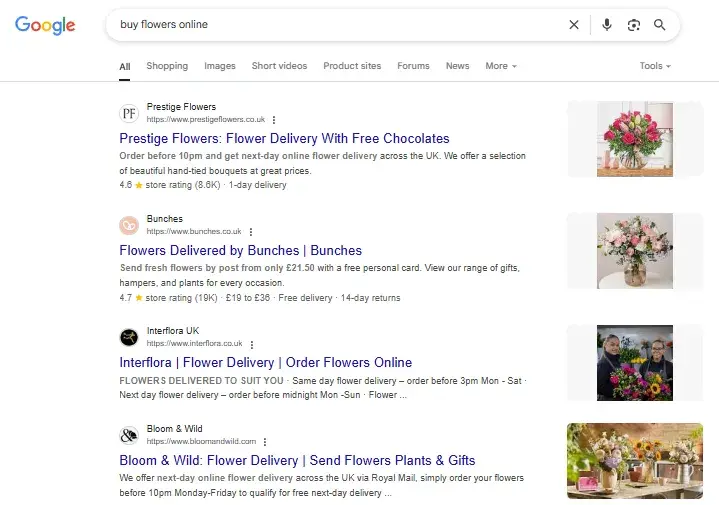
Although the transactional keywords listed above have a high search volume, this often isn’t the case, especially in complex B2B. With the new way of doing keyword research, search volume isn’t an issue, because high search volumes can result in zero clicks. It’s quality clicks that matter.
I talked to HubSpot Growth Manager Amal Kalepp, who echoes this sentiment.
Kalepp warns that one of the common mistakes people make is assuming that a higher monthly search volume (MSV) is better. “‘Instagram marketing’ might seem like the best keyword to rank for because it has millions of searches,” she says. “But it makes it much more difficult to rank.
“You might have better luck with something like ‘Instagram marketing for small businesses’ — and then that can be your niche.”
She says you could get “a lot more traffic ranking for a keyword with a lower MSV and lower competition” than one with a high MSV.
4. It helps you increase revenue and meet business goals.
When you understand your buyer and research the right keywords, you’re on the path to making money directly from SEO efforts.
Revenue-generating SEO is what keeps budgets flowing and decision-makers and stakeholders happy.
There is one complication with keyword research and ranking. While it’s easy for me to say that we need to target bottom-funnel keywords, we also need to be able to rank for them.
5. You can determine whether or not a site will rank for desired keywords.
Keyword research helps us determine whether or not our site has a chance of ranking.
Kalepp says that keyword research “determines who your competitors are and which area of the search landscape you can rank for. Doing keyword research and understanding where your blog or website sweet spot is — that’s what gives you rankability.”

In other words, when we search for a keyword, we can see who our competitors are (those ranking), and whether or not our site has a chance of ranking, too. I cover this in detail in the section “Prioritize low-hanging fruit.”
Elements of Keyword Research
Keyword research can feel complex, so let’s change that by breaking it into four primary elements.
Audience Needs
First, you need to know what your audience needs from you. Without it, how are you going to help them?
Identifying your audience's needs can stem from keyword research. You can use tools (listed below) to see what people are searching for.
I love understanding audiences through keyword research, but I don’t like relying entirely on keyword research. Instead, I want to talk to my audience, sales teams, and customer service to hear from them.
Ask customers or prospective buyers:
- What was happening in your business when you started looking for a solution?
- What was the biggest challenge you were facing?
- What would have happened if you hadn’t solved this problem?
- What did we do that helped you solve problems?
- What do you wish we could’ve done better?
- What information do you wish you had understood earlier in the process?
- What other solutions did you consider before choosing us? Why?
- What made you choose us over others?
- Was there anything that nearly stopped you from buying?
- Who was involved in the decision?
- How did you research or find information before making a decision?
Pro tip: Use the audience insights to create buyer personas. You can create a buyer persona for free using HubSpot’s Make My Persona Buyer Persona Generator. It’s easy, and the workflow will ensure you don’t miss anything. If you want help creating detailed buyer personas, read: How to Create Detailed Buyer Personas for Your Business
Ask sales or customer service teams:
- What are the most common objections you hear?
- What questions do prospects ask most often on calls?
What part of the sales process do leads get stuck on? - What triggers a buyer to start looking for a solution like ours?
What language do buyers use when describing their problems?
- What do customers get confused about the most?
- What features or benefits do they rave about?
- Are there recurring issues or complaints?
- What do customers often ask for that we don’t offer?
- What types of customers seem the happiest (or least happy)?
- What assets do you most need to help your workflow process?
Pro tip: Use this information to answer frequently asked questions that are integral to shaping the customer experience. Knowing what your sales and customer service teams need to improve workflows gives your content and assets extra value. If you create a blog, for example, and sales and customer service share it, they’re saving time on nurturing, and your content is getting eyes on it without relying on search.
Search Behavior
You need to know where your audience is searching before you can create content for them. Your audience research should give you some ideas, and you can use tools like Google Search Console (GSC) and Google Analytics (GA4) to see how people like to search.
Google Search Console
Google Search Console shows what people search for to find your website and how many searches get clicks.
Here’s what the report looks like.
Go to GSC > Performance > Queries.
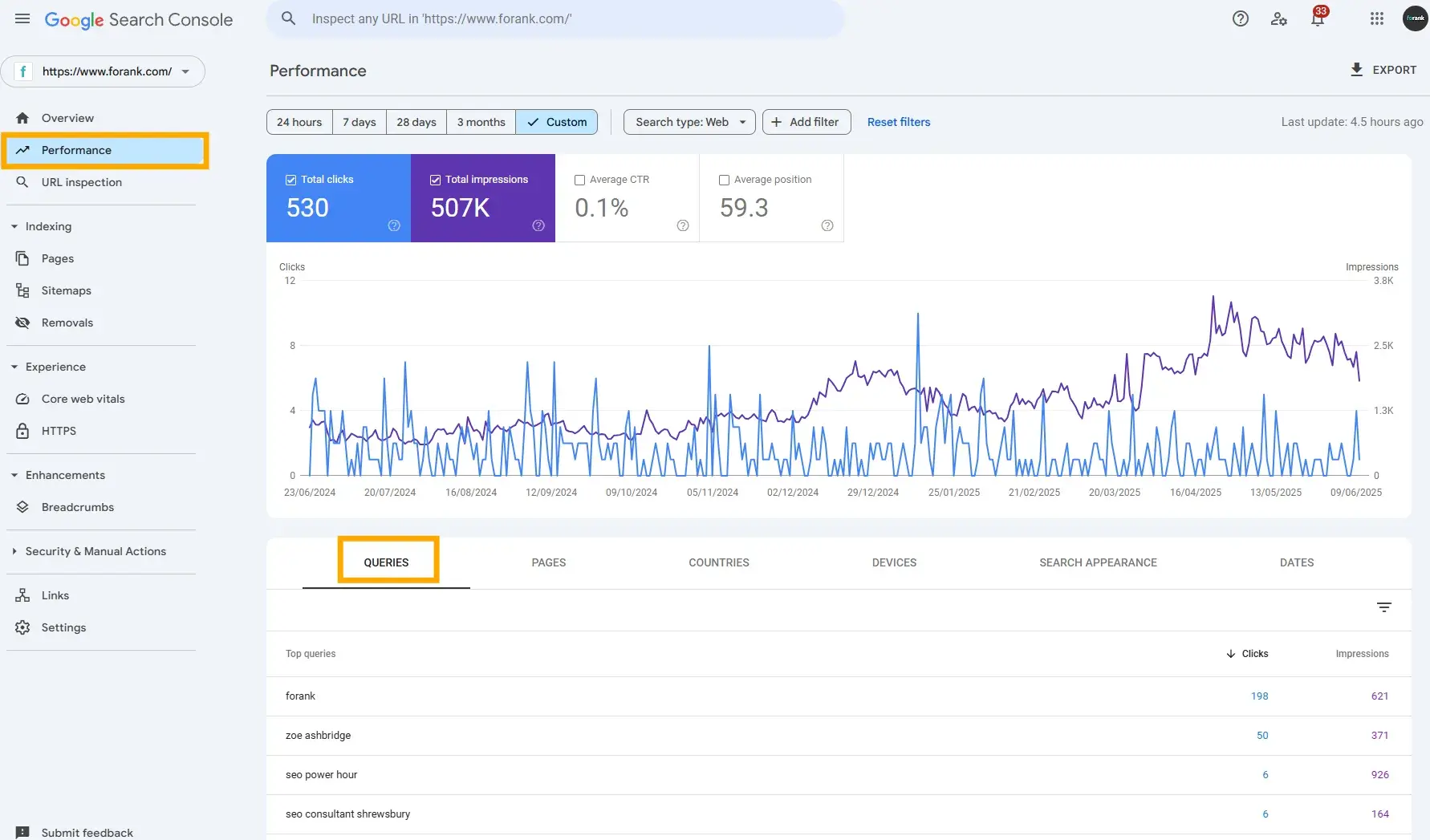
Any searches that resulted in an impression or click are listed here. You can use this report to see what your audience is searching for you and which queries result in the most clicks.
From the screenshot above, I can see that most people search my brand name, followed by my name, to click my site; it makes sense since most of my marketing is done via LinkedIn. The next most popular keywords are listed.
Google Analytics
GA4 has a report that helps you see where traffic has come from. Here’s how to find it.
Go to GA4 > Find your project > Reports > Acquisition > Traffic Acquisition
In the report, hit the plus next to the drop-down “session primary…channel group” and add “session source/medium.”
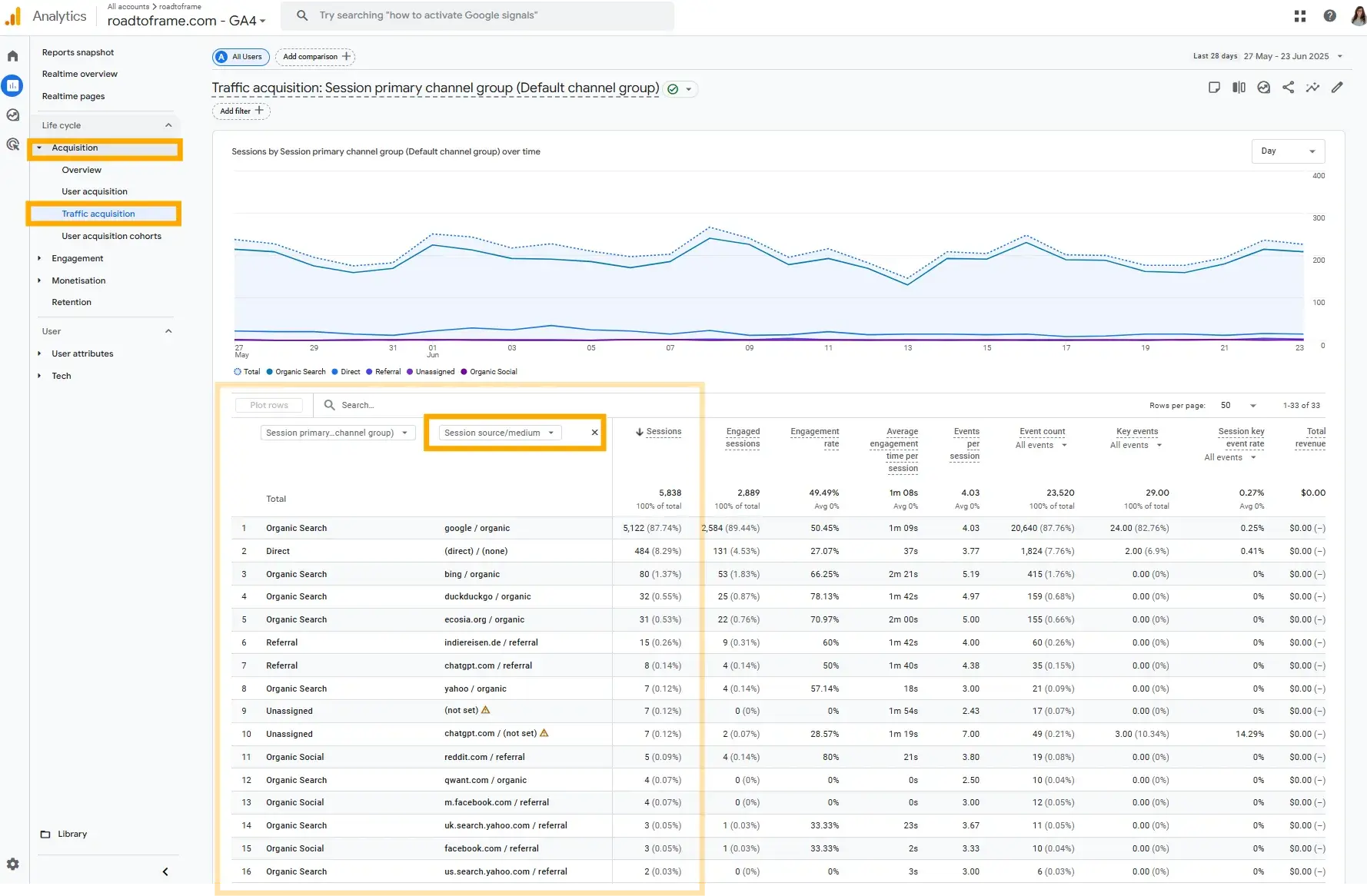
In the screenshot above, I can see that visitors to my blog are coming from:
- Google (87.74%)
- Bing (1.73%)
- ChatGPT (0.12%)
- Reddit (0.09%)
It appears my audience is most active on Google.
One very important caveat: This data is owned data, and it only shows how people are finding my site.
Why does this matter?
Because there could be untapped opportunities.
To find untapped opportunities, it helps to do broader research using typical user demographics.
For example:
Axios found that just over a quarter of 18 to 24-year-olds start their search on video platforms such as YouTube and TikTok. Knowing this, if this age demographic is your target audience, maybe you need to think about keyword research on video platforms.
In its latest Consumer Trends Report, HubSpot found that more men prefer generative AI search than women. Men (33%) are significantly more likely than women (25%) to find gen AI–powered search “much” more appealing for online shopping.
The takeaway?
Considering the audience and their preferences, you can tailor your efforts to the platforms users prefer based on user behaviour. Meeting user preferences likely increases conversions. If you’re targeting Gen-Z, keyword research on video platforms might be best. If you’re selling products to men, prioritizing keyword research for LLMs might be the way forward.
3. High-Quality Content and Relevance
Google ranks content based on relevance.
- The content needs to make sense for your business. This means: no creating content, just competitors are.
- Content must meet search intent, meaning the content you create is precisely what the searcher (your audience) is looking for.
Your content will only rank for a keyword if it meets the searchers’ needs.
In addition, your content must be the best resource for the query; Google won’t rank your content as highly if it doesn’t provide better value than its competitors.
4. Site Authority
Google gives more weight to sources it deems authoritative. So, how do you become an authoritative source? Start by enriching your site with helpful, informative content and promoting that content to earn social signals and backlinks.
HubSpot.com and the HubSpot Blog are well-established sites, and we work hard to ensure we provide the content our readers are searching for.
As a result, the root domain and subdomain have very high domain authority:

If you’re not seen as authoritative in the space, or if a keyword’s SERPs are loaded with heavy sources you can’t compete with (like Forbes or The Mayo Clinic), you have a lower chance of ranking.
How to Research Keywords for Your SEO Strategy
- Make a list of important, relevant topics based on what you know about your business.
- Identify keywords for the conversion-driven page.
- Choose your supporting content and buyer journey keywords
- Map your keywords and document your keyword research.
I’m going to lay out a keyword research process you can follow to help you come up with a list of terms you should be targeting.
That way, you’ll be able to establish and execute a strong keyword strategy that helps you get found for the search terms you care about.
Step 1. Make a list of important, relevant topics based on what you know about your business.
Before you do anything else, think about the topics you want to rank and come up with one to three different topics you’d like to focus on.
There is nothing wrong with a bit of common sense when it comes to keyword research.
Important note: You can do as many topics as you like, but in my ten years of experience, working across various industries, one to three topics is usually enough. The risk with doing too many is that you don’t work on anything particularly well, and resources are spread too far.
Remember that you need to create content to rank for these topics, and that’s time-consuming. Keyword research and SEO are never complete, and once you’ve moved a site for one to three topics, you can find a few more to focus on.
Refer to the audience research aforementioned. Find out precisely what prospects and customers searched and what challenges they had to resolve before working with you or buying your product.
Not sure where to start? Think about what you want to be known for. You can also put yourself in the shoes of your buyer personas and think about what they want to know.
HubSpot, for example, might have topics like:
- “SEO” (246,000)
- “blogging” (9,900)
- “CRM software” (60,500)
- “social media marketing” (49,500)
- “email marketing” (33,100)
- “lead generation” (18,100)
- “inbound marketing” (9,900)
- “marketing analytics” (6,600)
- “marketing automation” (14,800)
- “AI marketing” (5,400)
- “AI CRM” (1,300)
The number in parentheses is the MSV, according to Semrush.
That data allows you to gauge how important these topics are to your audience and how many different subtopics you need to create content on to be successful with that keyword.
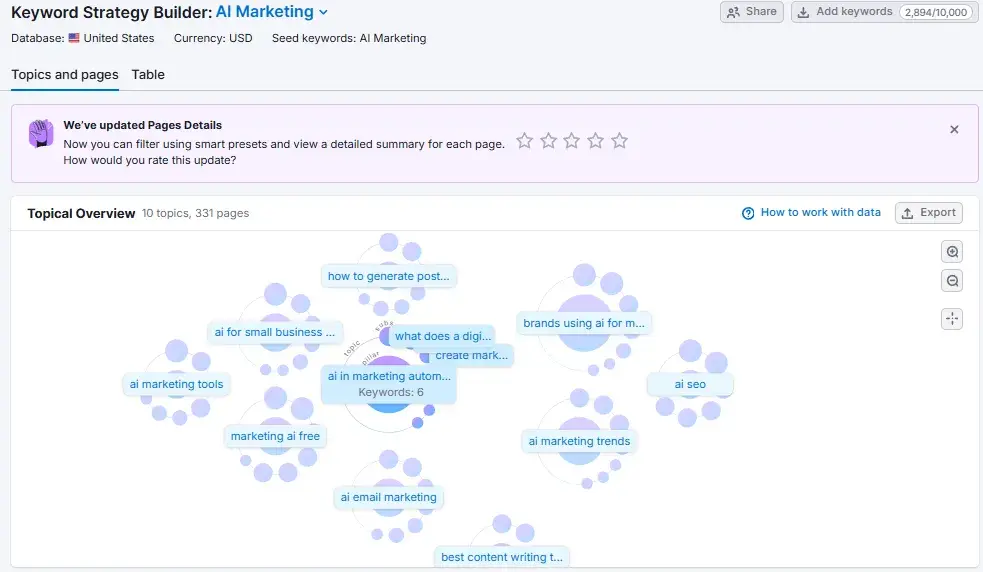
Now we’ve got topics, we need to flesh out content ideas and start keyword mapping.
Step 2. Identify keywords for the conversion-driven page.
Every step of keyword research for SEO, and any search platform, such as ChatGPT or social media, should be completed with the conversion goal in mind.
Although conversion is the final step in the buyer journey, starting with this page is critical because it helps keep a strategy focused. If you know where you want audiences to end up (on the conversion-driven page and buying something or enquiring about it), you can strategize to make that happen.
For example, sticking with the “AI CRM” topic above. HubSpot needs a page designed to convert people who need AI CRM solutions.
First, we need a commercial or transactional keyword.
Commercial keywords are searched by people investigating brands or services.
Transactional keywords are searched by people ready to take action.
I use Semrush’s Keyword Magic Tool to identify the intent behind a keyword.
I typed in “AI-Powered CRM” and found the following:
- AI-powered crm (320)
- AI-powered crm tools( 30)
- AI-powered crm (30)
All of these searches have commercial intent.

Important note: You do not have to use Semrush to do this. I share more tools below, including free tools, but Ahrefs also does this well. Here’s what search intent looks like on Ahrefs:
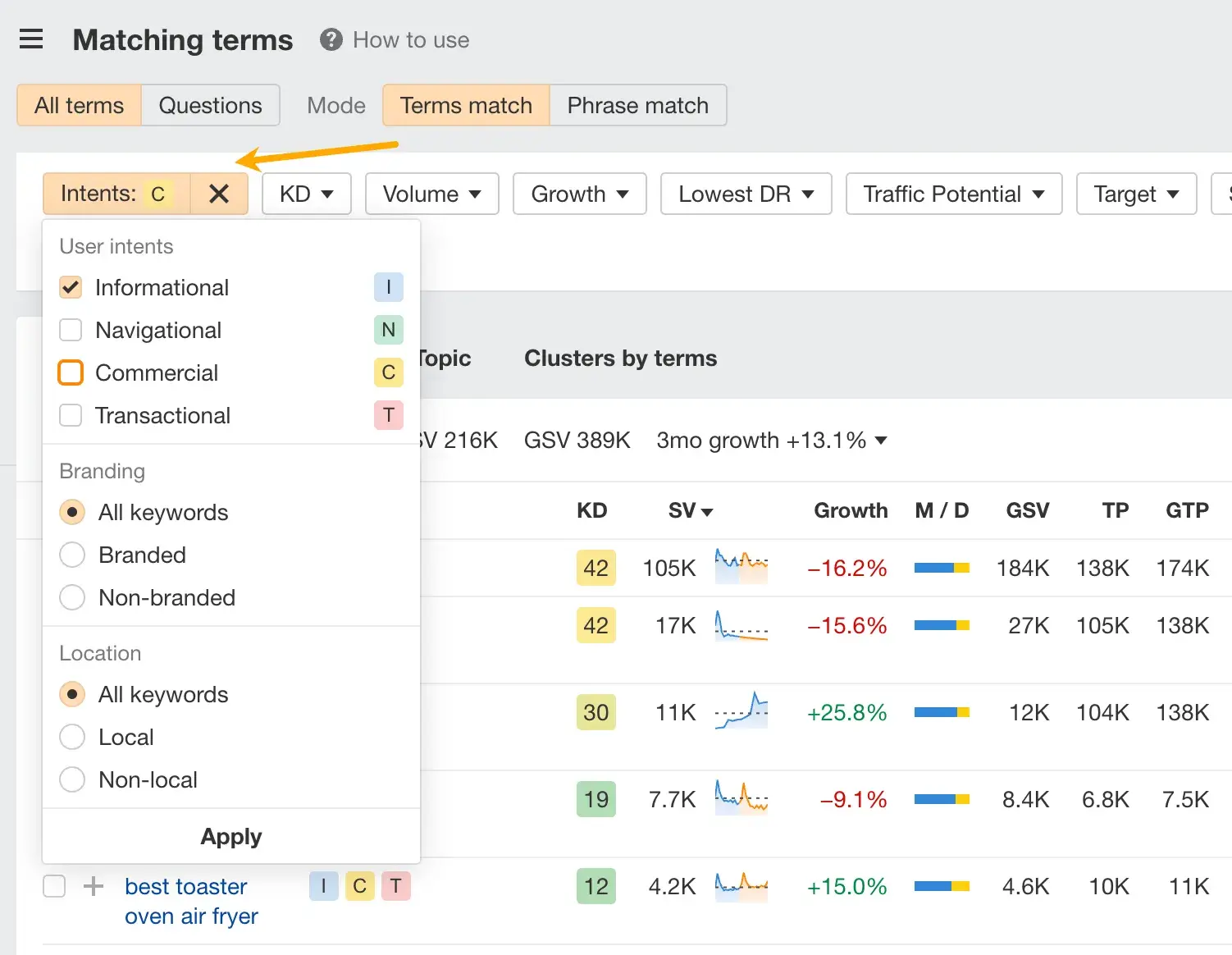
If you don’t have access to tools, you can do this manually and for free!
Here’s how:
Type your keyword into Google and see what comes up.
A search for “AI Powered CRM” shows the following results:
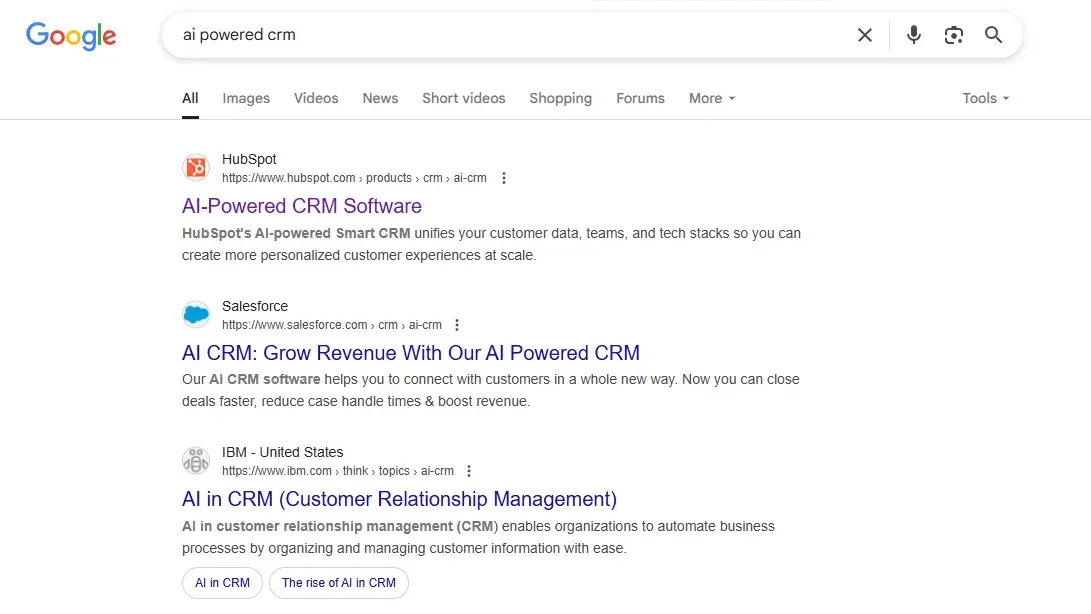
The top results are product pages. Therefore, you can assume that the search intent is commercial and/or transactional. Google is showing pages that people can easily convert on.
To help you identify a transactional or commercial keyword, here are the SERPs for informational searches.
I typed in, “Should I use a CRM?” and the result looks like this:
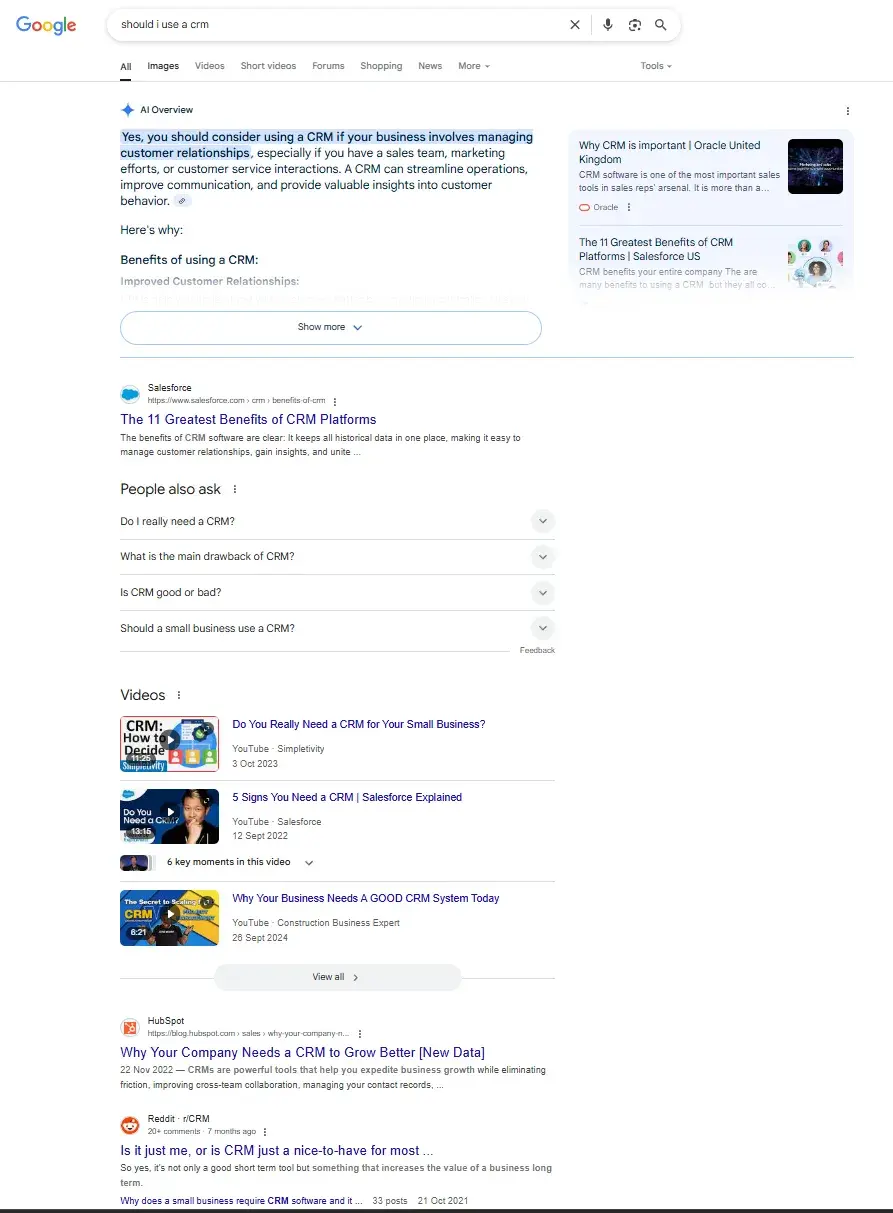
Instead of conversion pages, Google prioritizes informational pages such as:
- AI overviews
- Blogs
- Informative videos
All of the above point to informational search.
Okay, so now you know which keywords show the money-generating page. Your next task is to create a page that efficiently uses your researched keywords, giving it the best chance of ranking.
Here’s a screenshot of HubSpot’s bottom-funnel, conversion-driven landing page for the commercial keyword “AI Powered CRM”:
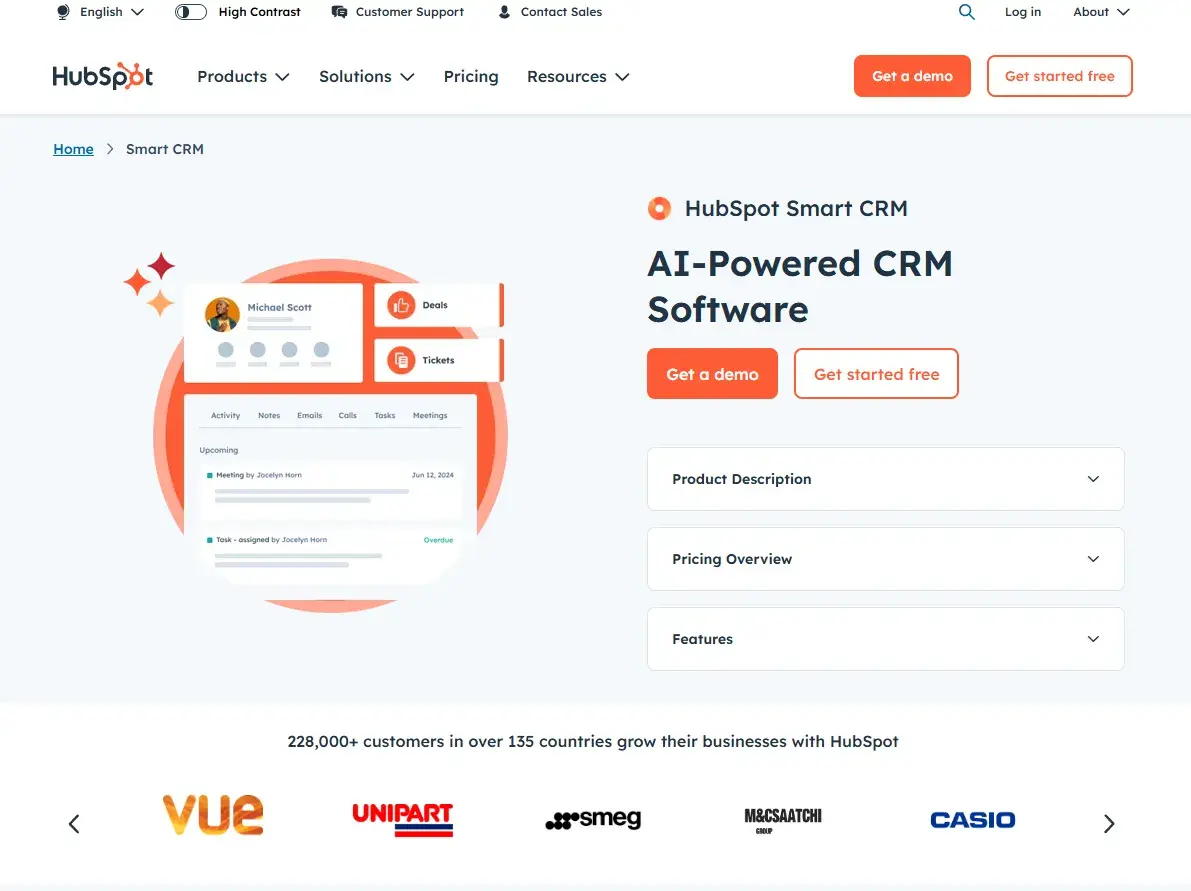
You can see it's driven for conversion because you can:
- Easily convert by clicking “Get a demo” or “Get started free” in the hero.
- Access key information such as “Product Description,” “Pricing Overview,” and “Features.”
- Feel safe with the solution because large HubSpot customers like Vue, Unipart, Smeg, and Casio are listed.
This is the type of page you need to create.
Now, all we’ve got to do is get visitors to it via search. If only that were easy.
The long-term goal is to create a keyword strategy that:
- Ranks your page number one on search engines.
- Earns citations within AI overviews and large language models (LLMs) like ChatGPT and Perplexity.
- Has your audience abuzz so they’re recommending you on social media and referring to friends.
Naturally, it’s not as easy as sticking up one converting page; the strategy must span the buyer journey.
This is where buyer journey keywords come in. I use them to support content that funnels audiences to the conversion-driven page when it's right.
I’ll talk you through that next.
Step 3. Choose your supporting content and buyer journey keywords.
Now that you have topics and conversion-driven pages that you want to focus on, it’s time to identify keywords for supporting content.
For this, you need to think about the entire buyer journey.
It’s unrealistic to create a page designed for conversion and expect people to convert from you sharing it. There’s a long way to go before a person is ready to buy. An average B2B sale is 379 days, and data shows that the decision time before buying in B2B increases yearly.
Compared to B2B, B2C sales are faster and have mostly one-off purchases.
When a buying process takes a year or more, your brand must be at the front of mind.
Here’s a simplified buyer journey:
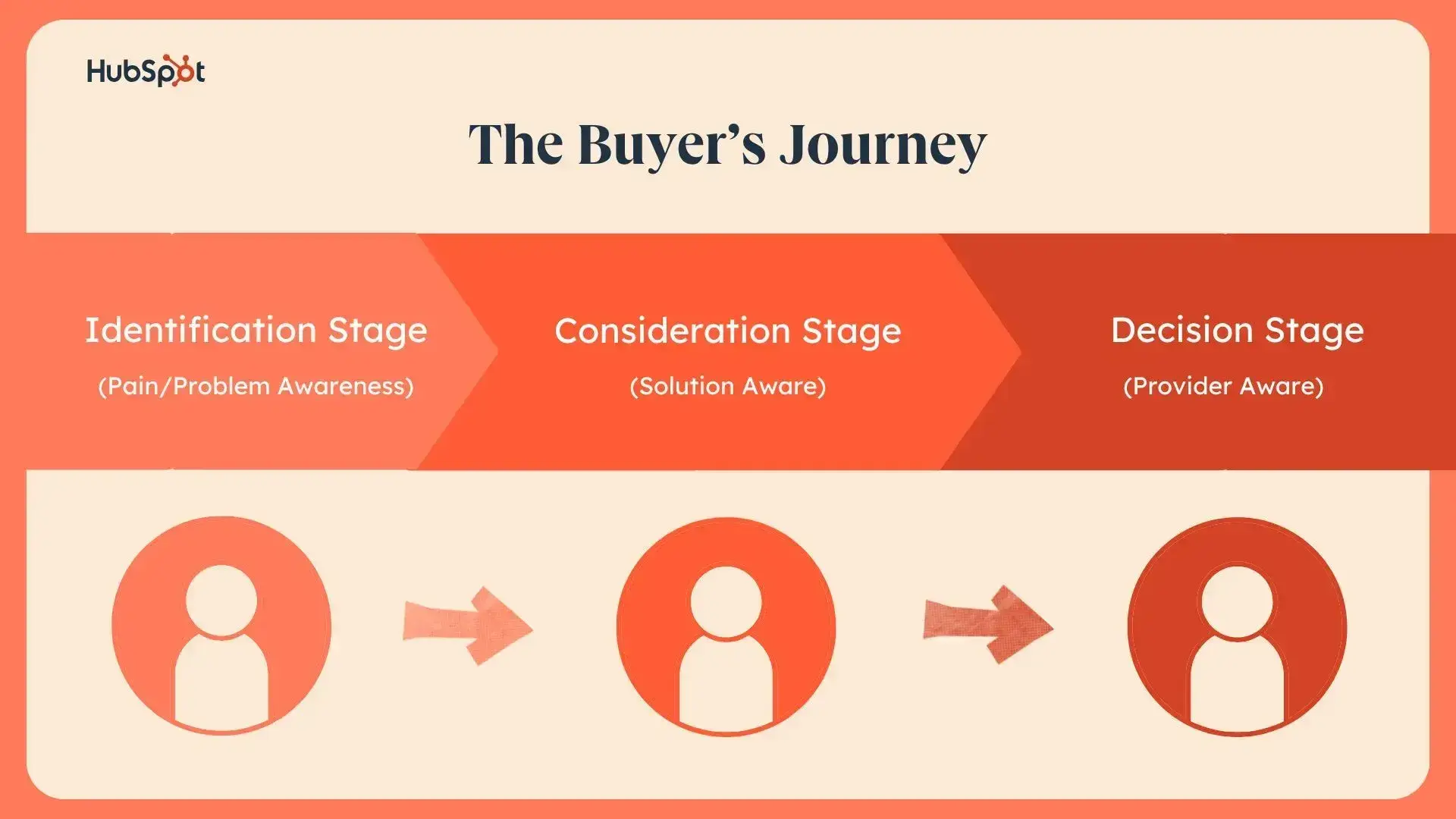
Keyword research can help you identify suitable content pieces for every step of the buyer journey. The step before this (Determine your conversion page and its associated keywords) focuses on the decision stage.
Good keyword research works backwards through the buyer journey to keep content relevant and as close to conversion as possible. If you start with the identification stage, it’s easy to get overwhelmed by informational topics; you can end up following tangents that aren’t as related to the conversion as they need to be for a successful keyword and marketing strategy.
Your SEO keyword research tools will help you find content across each stage because you can filter by search intent.
I want you to think about keyword phrases you want to rank for in the SERPs (search engine results pages) because your target customer is probably conducting searches for those specific terms.
Sticking with the “AI CRM” page, the goal is to create content that ranks and supports the buyer journey.
HubSpot has done this well. Here’s some of the content that helps people who need AI CRM and are in the consideration phase:
- I Tried Three Generative AI CRMs: Here Are My Thoughts
- 9 CRMs That Now Offer AI (and How to Make the Most of Them)
I wrote both of these articles, and they help people in the consideration stage because I recommended tools they might need. Most people who need an AI CRM don’t have the time to test every single one, but I alleviated some of this for them and will help them shortlist the best CRMs for them. This content isn’t about heavily pushing the HubSpot solution; it’s more about providing the information required for the consumer to make the right decision.
A more informational topic for buyers higher up the funnel might include How to Choose the Best Free CRM System.
Step 4. Map your keywords and document your keyword research.
As you complete the steps outlined above, you’ll want a database to map your keywords to topics.
Keyword mapping is the action of assigning keywords to content that gives that keyword the best chance of ranking. To do it well, you need:
- The keyword
- The intent
- The type of content that’s ranking
I like to use a Google Sheet to map keywords. Here’s what my sheet looks like:

I have columns for the following details.
- Priority: The highest priority topics are those that should be created first.
- Status: Where the content is within a workflow (eg, briefing, writing, designing images, editing, published)
- Brief submitted: The date a brief was submitted to the writer.
- Title: Page title I use the heading or the title tag here.
- Focus keyword: The most important keyword that I want the content piece to rank for.
- Supporting keywords: Additional keywords that I want the content piece to rank for.
- Writer: The person responsible for writing the content.
- Pillar: The topic the piece belongs to. This is usually the main topic (like AI CRM).
- Page Type: The type of page we need to create for the content to have the best chance of ranking (eg, blog page, landing page, product page, etc.)
- New, Edit, or Rewrite: Whether the content is new or existing. I like to differentiate between an edit (light editing to an existing page) and a rewrite (significantly editing the content, perhaps even taking the content down and starting again).
- Notes: Any notes I might want to remember for later. Perhaps a noteworthy insight will help the briefing process or the writing.
- Content brief link: I create my briefs in Google Docs and link them here.
- Live link: is the URL on which the content is published.
I use this document to manage my workflows and remember where I’ve mapped my keywords. It’s important because as your topics get bigger, you need to keep track of keywords already covered.
I often customize this template depending on client needs and workflows. For example, you might also add:
- Editor: The person handling the editing of the writing.
- Word counts: To help manage writing budgets and expectations for a content’s length.
- Buyer persona: The audience for which the content is created.
The beauty of a Google sheet is that you can customize it however you like.
5 Tips for Finding and Choosing Keywords for Your Website
- Prioritize low-hanging fruit.
- Check the monthly search volume (MSV) for keywords you’ve chosen.
- Factor in SERP features as you choose keywords.
- Check for a mix of head terms and long-tail keywords in each bucket.
- See how competitors are ranking for these keywords.
Once you know the keywords you want to rank for, it’s time to refine your list based on the best ones for your strategy. Here’s how.
1. Prioritize low-hanging fruit.
Prioritize keywords that you have a chance of ranking for based on your website’s authority.
Large companies typically go after high search volume keywords, and since these brands are well established already, Google typically rewards them with authority over many topics.
You can also consider keywords that have little competition. Keywords that don’t already have multiple websites battling for the highest rank can afford you the spot by default, if there’s no one else trying to claim it.
Here’s an example:
Let’s say a new SaaS product has entered the market. A company has created a new CRM solution. The domain name was bought recently, and the site is live with the essential pages: a homepage, a product page, and some standard page templates like about and contact.
Eventually, the company wants to rank for the keyword “CRM.”
A search for this keyword shows the following top results:
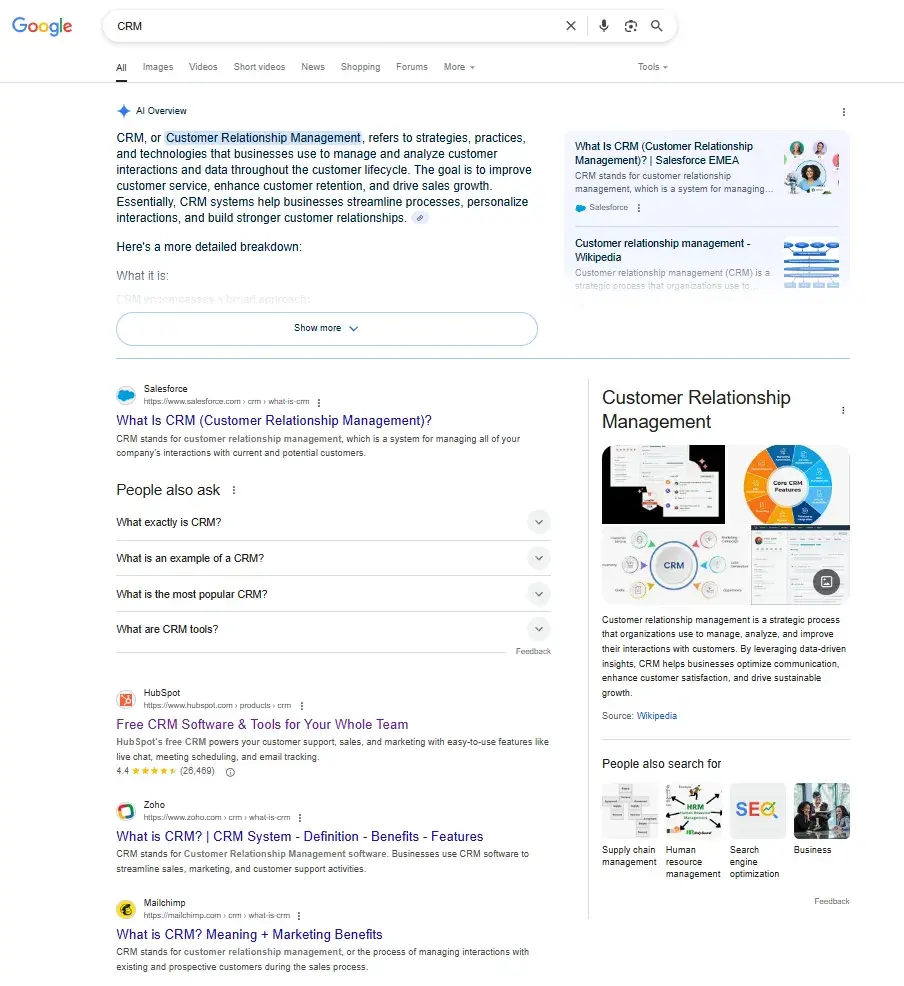
The top four ranking results include some of the largest SaaS companies in the world. A startup is extremely unlikely to rank here.
With this knowledge, the startup CRM company could instead rank for keywords with lower competition, for example, “crm for dental practices,” which returns much smaller companies, see the image below:
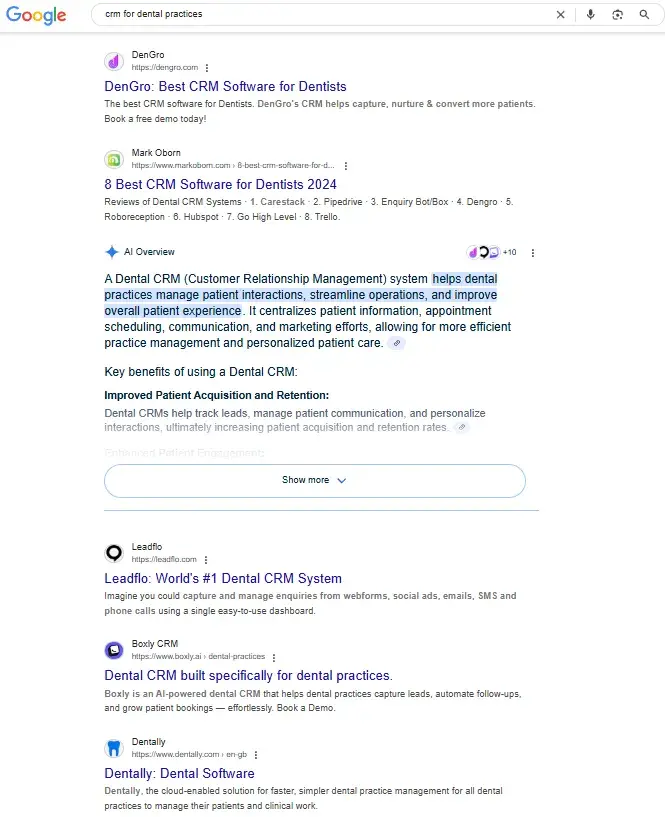
Keyword research can help us determine a website’s chances of ranking and weed out the low-hanging fruit, opportunities where a business can rank and differentiate its offering.
This is important for Google, but there are also benefits for AI search.
Identifying niches can help websites stand out in AI search tools like ChatGPT. When I wrote about the Future of SEO for HubSpot, I spoke to Nate Tower, president at Perrill, who had some interesting insights about AI search. He said that people searched ChatGPT differently from Google. They use longer-tail keywords and get hyper-specific.
“CRM for dental practices” is much more specific than “CRM,” and brings us closer to how people search in LLMs.
Here’s an example of a longer tail keyword and my client's ranking in the top spot within the AI search:

We achieved this through keyword research and understanding buyer needs. We know there’s a need for a service like this, so we created a page targeting the keyword and earned the ChatGPT citation and the rank on Google.
Check the monthly search volume (MSV) for keywords you’ve chosen.
You want to write content around what people want to discover, and checking MSV can help you do just that. Monthly search volume is the number of times a search query or keyword is entered into search engines each month.
Here are the results from Semrush on “SEO keyword strategy,” which has an MSV of 390:

Tools like searchvolume.io or Google Trends can help you find the most searched keywords for related keyword clusters for free.
2. Factor in SERP features as you choose keywords.
Certain keywords return certain enhanced listings called SERP features or rich snippets.
I will share some of the most common ones below, but there are more than 40 — you can read about them on Google.
I’ll summarize the more common snippet types here.
Image Packs
Image packs are search results displayed as a horizontal row of images that appear in an organic position. If there’s an image pack, you should write an image-heavy post to win placement in it.
For instance, here’s the image pack for “what is the buyer journey”:
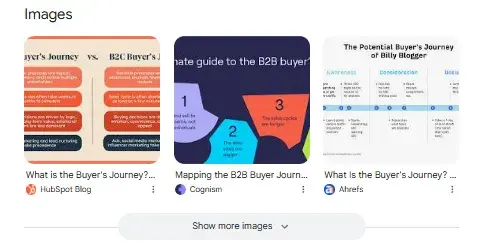
AI Overviews
A relatively recent addition to Google’s SERP features, AI Overviews provides an AI-written summary for some searches.
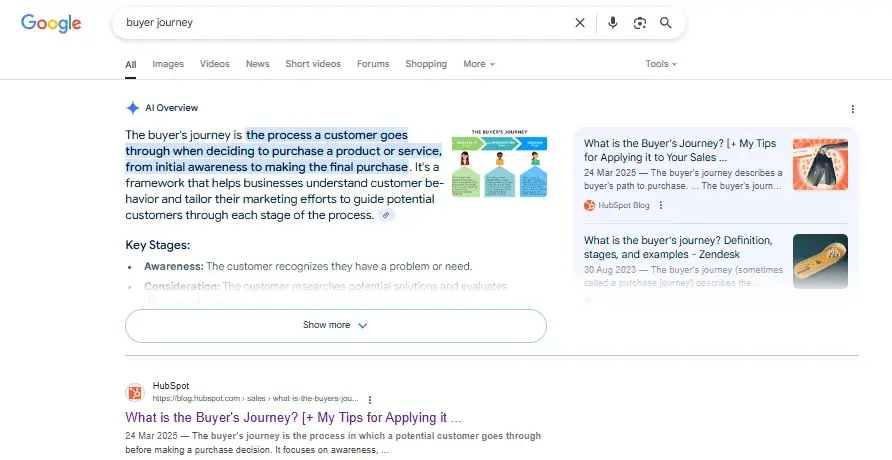
Featured Snippets
Featured snippets are short snippets of text that appear at the top of Google search results for quick answers to common search queries. I asked Google, “Where do elephants live?” and it returned this featured snippet:

Understanding the searcher’s intent and providing succinct answers can help you win a featured snippet.
List Snippets
List snippets, or listicles, are made for posts outlining steps to do something from start to finish, often for “How To” searches. Writing posts with direct, clear instructions and formatting can assist in winning this placement.
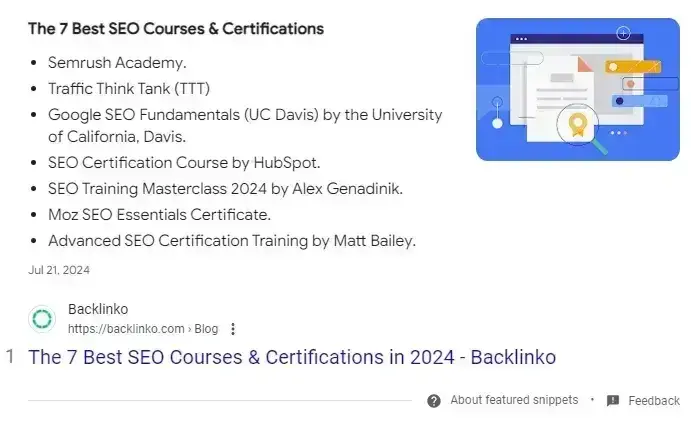
Video Snippets
Video snippets are short videos that Google displays at the top of a SERP instead of text-based featured snippets.

Posting a video on both YouTube and your website can help you win this placement if you’re tagged in the targeted keywords people are searching for.
3. Check for a mix of head terms and long-tail keywords in each bucket.
Head terms are keyword phrases that are generally shorter and more generic, typically just one to three words in length.
Long-tail keywords, on the other hand, are longer keyword phrases usually containing three or more words.
You should have a mix of head and long-tail search queries to build a well-balanced keyword strategy with long-term goals and short-term wins.
Head terms are generally searched more frequently, making them often (not always, but often) much more competitive and harder to rank for than long-tail terms.
Think about it: Without looking up search volume or difficulty, which of the following terms would be harder to rank for?
- How to write a great blog post
- Blogging
If you answered #2, you’re right. Here’s the breakdown:
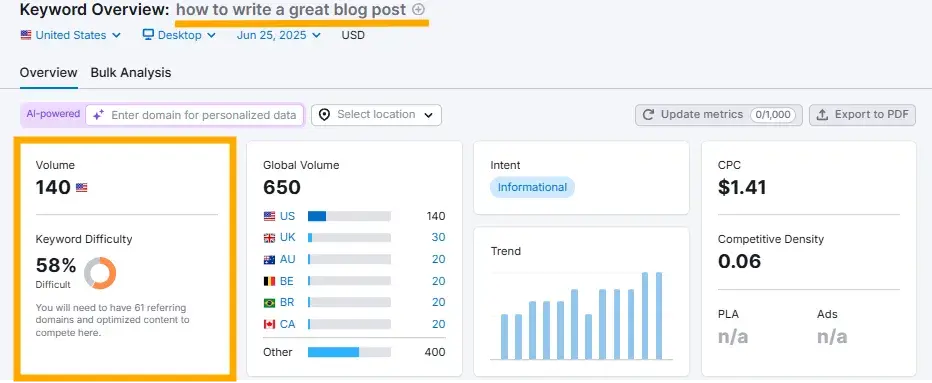

Head terms generally boast the most search volume (meaning greater potential to send you traffic), but the traffic from “how to write a great blog post” is probably more desirable because people using specific queries are more likely to be your ideal audience than those searching more generally.
Because long-tail keywords tend to be more specific, it’s usually easier to determine search intent. Someone searching for the head term “blogging” might not be your target audience.
Kalepp says that head keywords “can make it really difficult to rank, especially if you are a newer blog and you don’t have that domain authority quite yet.”
She recommends “targeting those long-tail keywords, because often the competition is lower on them. And it allows you to develop a niche and allows you to rank.”
Pro tip: Check your keyword lists for a healthy mix of head terms and long-tail keywords to give you quick results and a long-game advantage.
Kalepp, who’s worked on both the HubSpot and The Hustle blogs, says it can be challenging to find the right balance.
When she worked on the HubSpot blog, “there wasn't a lot of fluctuation in what the search volume looked like, but for The Hustle blog, there were constant changes because we were writing about subjects that were really trendy.
“And so it was imperative for us to strike when it was hot,” she says of The Hustle blog.
4. See how competitors are ranking for these keywords.
Just because a keyword is important to your competitor doesn’t mean it’s important to you. However, understanding what your competitors are trying to rank for is a great way to help you give your list of keywords another evaluation.
If your competitor is ranking for certain keywords that are also on your list, it makes sense to work on improving your ranking for those.
Kalepp says she’s a big fan of “doing a competitor analysis and understanding that landscape really well — and then using those same content pillars to build out a content library.”

Don’t ignore the ones your competitors don’t seem to care about — it could be a great opportunity to own market share on other important terms.
Pro tip: A quick way to understand which terms your competitors rank for is manually searching for keywords in an incognito browser to see your competitors' positions.
5. Think about topics versus keywords.
“Search intent” is something I frequently hear about from HubSpot SEOs. That’s because the reason a user types in a particular keyword matters — a lot.
Our content has to solve users’ problems. If you found your way to this article via the search term “SEO keyword strategy,” we have to anticipate your questions on this topic. And then answer them.
SEO is evolving at breakneck speed, but keyword research remains foundational to search intent. It tells you what topics people care about and how popular those topics actually are among your audience.
The operative term here is “topics,” plural. By researching keywords with a high volume of monthly searches, you can identify and sort your content into topics or buckets that you’ll use to create content.
Then, you can use these topics to dictate which keywords you look for and target.
Keyword Research Tools That Help With the Process
Keyword research and SEO tools can help you brainstorm more keyword ideas based on exact-match keywords and phrase-match keywords based on the ideas you’ve generated up to this point. And with AI-enabled tools at your fingertips, SEO research is more accessible than ever.
Throughout this article, I’ve referenced some of my favorite tools (Google Search Console, Google Analytics, Semrush, Moz, and Ahrefs). Still, there are so many more tools that suit different needs and budgets.
Here are a few popular options to try:
Google Keyword Planner
Google’s Keyword Planner is an ad tool that can be very useful for SEO keyword research.
It’s completely free to use, which makes it highly desirable for some. You need an AdWords account to use it, but you do not need an ad running. In the past, I’ve set up ads and then just paused them to get access to this free tool.
Once you’ve got an account, here’s how you find Keyword Planner:
Tools > Keyword Planner > Discover new keywords
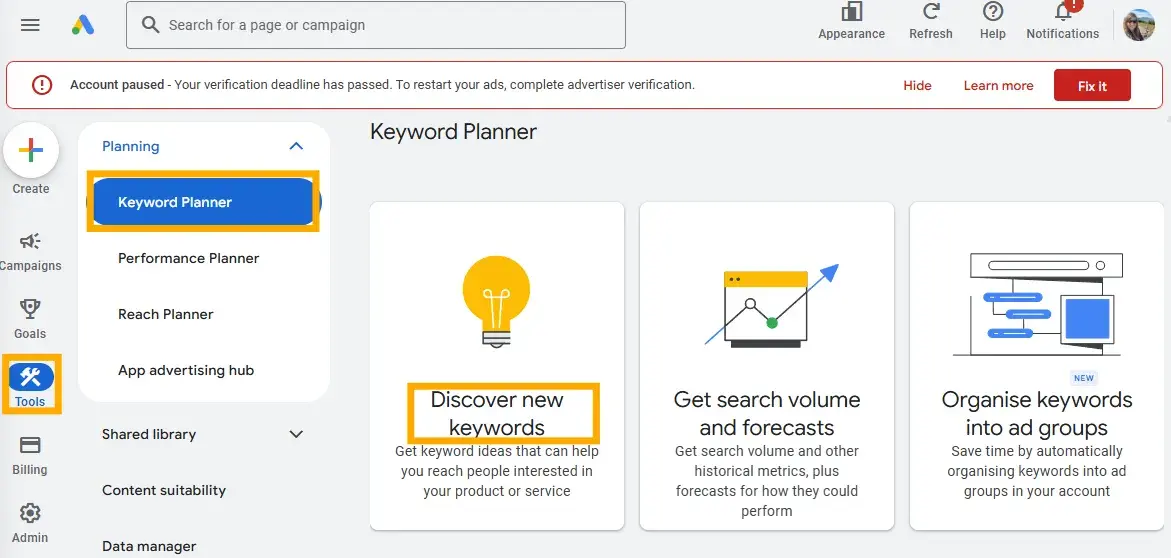
You can get search volume and traffic estimates for keywords you’re considering. Type in the keyword and see what Google Keyword Planner suggests.
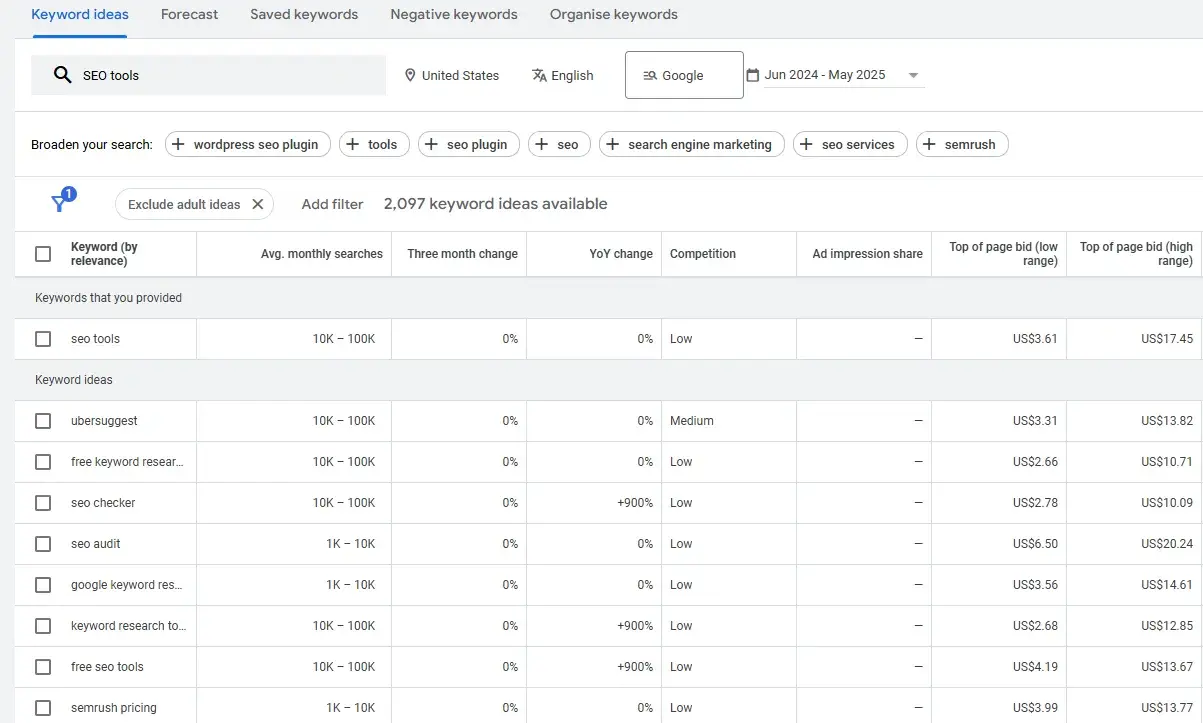
Level up this research by taking the keywords into Google Trends to fill in some blanks.
Google Trends
Have a look at the trend history and projections in Google Trends to see if there’s any seasonality to the phrase. Google Trends can help you determine which terms are trending upward and are worthy of your focus.
An upward trend like the one below suggests the keyword is trending now and worth covering.
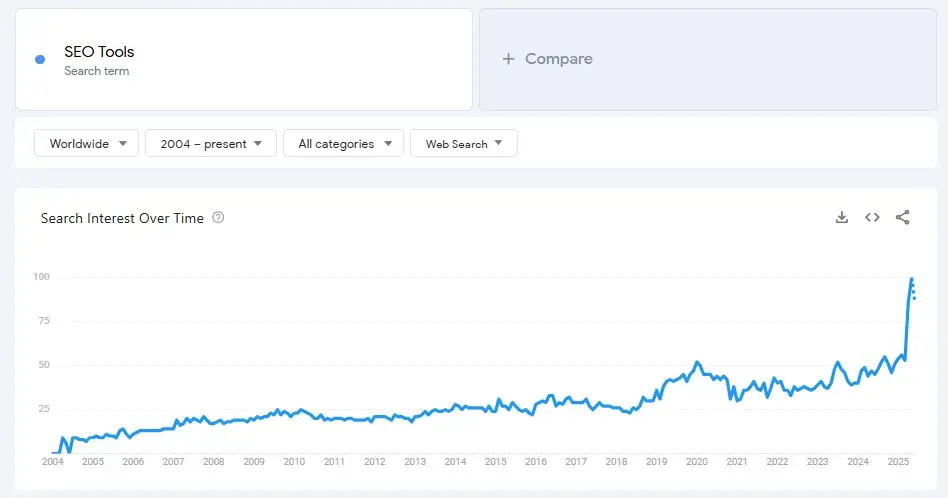
A downward trend suggests the keyword/topic is less popular than it used to be and may not be worth pursuing.
Another Free Keyword Research Tool is RyRob’s easy-to-use keyword research tool, which provides keyword and keyword cluster topics.
Keywords Everywhere is a firm favourite of mine. It’s so cheap that I use it alongside Semrush for analysis within SERPs. I like the Chrome extension that brings some keyword insights into the SERPs. Here’s what it looks like:

HubSpot Marketing Analytics Software
Once your keyword research is complete and strategies are underway, it’s important to measure marketing success so you can iterate on the process and get more traffic.
HubSpot’s Marketing Analytics Software allows you to manage the performance of all your marketing campaigns in one place with built-in analytics, reports, and dashboards.
- Marketing Analytics
- Dashboard Software
- Website KPIs
- And More!
Get started with HubSpot’s free Traffic Analytics Tool.
Drill down into your website’s traffic sources and sift through your organic search traffic bucket to identify the keywords people use to arrive at your site.
Repeat this exercise for each of your topic buckets.
Having trouble brainstorming with relevant search terms? You can always head over to your customer-facing colleagues in sales or service. Ask them what types of questions they’re fielding.
Those are my favorite starting points for keyword research. In addition to creating great SEO-optimized content, this step allows you to create helpful resources to share with customers and to use in marketing campaigns.
HubSpot uses the Search Insights Report, a template designed to help you bucket your keywords into topic clusters, analyze MSV, and inform your editorial calendar and strategy.
Featured Resource: Search Insights Report Template
You’re ready to build out your SEO content.
Keyword research is still really important, and I hope this article has given you the insights you need to conduct keyword research in a way that supports business goals.
Here are a couple of articles that I think will help you develop your keyword research skills in a way that future-proofs your strategy:
- How to use buyer journey keyword research to unlock SEO-generated revenue
- What the buyer’s journey looks like in 2025: Action-packed insights from 4 major studies
Editor's note: This post was originally published in January 2014 and has been updated for comprehensiveness.
Keyword Research


.png)
